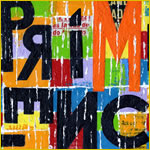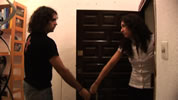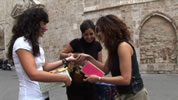

 TV REPORT
TV REPORT FILM
FILM SYNOPSIS
SYNOPSIS TECHNICAL DATA
TECHNICAL DATA CAST
CAST INFORMATION
INFORMATION THE STAGE
THE STAGE THE CHARACTERS
THE CHARACTERS PICTURES AND BOOKS
PICTURES AND BOOKS PHOTOS
PHOTOS 
SYNOPSIS
Filmed using a 76-minute sequence shot.
Mauro lives with his girlfriend a comfortable life. The problem for
him comes when one morning she decides to leave home and leave him
alone. She complains his passivity, his indolent life and especially
the lack of love between them. Mauro can not understand why she wants
to disappear because she has been everything for him, someone to love,
someone who financially sUpports him while he tries to break into the
world of graphic design. However, he is aware that from that time many
of the things that happen in his life will change.
Shot in real scenarios and in real time, the camera follows for an
hour and a quarter to three characters in an important moment of their
lives in which they know their views about the world will change but
they do not know which way to take or what it's their final destination
TECHNICAL DATA
Original Spanish Title: El primer silencio
Catalan Title: The first silence
International English Title: First Silence
French Title: Le premier silence
Director: Samuel Sebastian
Production: sinCasa
Producer: Samuel Sebastian
Story: Samuel Sebastian
Art direction: Luis Linares
Paintings: Ester Rodríguez – Ro: M, Valentina, The first silent
Photos: Samuel Sebastian
Music: Claude Debussy, Erik Satie
Camera: Samuel Sebastian
Coordination: Lucía Alcantud, Sandra Alcantud, Marta Pérez Soria
Post-Producer: Violeta Martín Núñez
Duration: 76 min
Up
CAST
Mauro Javi Velasco
Inés Paula Bares
Clara Estela Muñoz
Juanan Juanan Lucena
Anna Anna Mª Martínez
Up
INFORMATION
FIRST THE SILENCE: A FILM
FLOWING
Just like the color fields of American abstract painting seem to flow
and escape beyond the boundaries of the canvas, I wanted life to flow
on my first feature film, a film that begins just before the magic
word Action and ends after the shot.
The idea of bringing together real life and film life in the same way
was the most intense experience for me since I conceived the film.
I wanted the actors to be integrated perfectly into their roles, and
at the same time we left a good portion of random events, that's why
the characters walk in the streets, or the inclusion of a pet or the
continuous Up and down of stairs, which brings some tension to the
them.
At first, the actors felt a little helpless, with no script, no planning
of the film (they do not know that I was going to shoot the film in
just one shot) and with only a rudimentary notes about their characters.
But after some rehearsals they gave to the characters some life and
verisimilitude, and finally made a very good recreations and enjoyed
playing them.
We started to shoot only with an HDV camera and a microphone and I
think that reality does not take much more to be captured. The intensity
of the story and how the characters play a crucial time in their lives,
fits with the intensity I have lived similar episodes narrated in the
film. In particular, the sequence of Ines had happened to me a coUple
of years before and everything that happened I wrote in a page like
a diary and sent it to a friend. She said I could write a story with
that, but I didn't found convenient to show the sad decline of a former
classmate. Today, however, I see it differently, and so thought the
actress who plays her (Paula Bares): This film tells the story of someone
who is at the bottom of a well and she knows that many hands that help,
it will not ever leave him.
After this movie I understood more than ever that the film can capture
reality as it is, plainly, without mincing words, recurrent topics
or preset codes, without pretentious dialogues or improbable situations,
a fragment of life as a whole film. Dig a little deeper into the film
proposals that have addressed this issue as the cinéma vérité or Dogma
and go a little further: there is still a wide and rich field to be
discovered.
So, after this, I can only say: Let the life flows.
THE
STAGE
The division between indoors and outdoors of the classic movies, completely
disappears here: the characters move inside and outside of the house,
strolling around the neighborhood, they sit, they enter into a cafe
and the stage of the film is the same neighborhood in which they spend
their lives.
The protagonist's house was my house and we modify it with the artistic
director (Luis Linares) and I to suit the home for a couple with completely
opposite points of view about life: the part of Mauro is chaotic and
disorganized, instead of Clara's that is tidy and clean. Even their
names have opposite meanings.
Outside the house is an unpredictable space, full of noise, people,
music, life in the final.
I found attractive the idea of shot a café from the street, as if we
were looking at a painting. However, this distance is broken when the
characters leave the café and seems to jump out of the canvas to fill
the space previously occupied by the camera - viewer.
Anonymous musicians in the street contributed the idea of seeking spontaneity
and even the songs they play have expressive implications for the film.
At first, I was upset they stood there, basically I wanted quiet streets
but then I must say I liked their appearance, that piece of life was
like this and can not be changed.
THE
CHARACTERS
The three players had the merit to work selflessly for a work whose
methodology and completely unknown author. Or maybe it was this strange
proposal that motivated them to participate.
MAURO, Javi
Velasco
The many nuances of the character make the tender Mauro pass to the
ridiculous in just seconds. And it is this contradiction that underlies
throughout the film. For Mauro, his comfortable and safe life fades
away in a blink of an eye and from the moment he wakes up until he
goes back to bed at the end, a lot things have changed for him ...
almost all.
Javier Velasco could understand from the beginning the complexity of
chis haracter and we chose to portray him as someone passive, ridiculous
for being drawn by the circumstances. With his unique sense of humor,
the character is rich in details between the smile and the pain, but
mostlyhe has been able to play the deep feeling of loneliness that
pervades those who fail to be loved.
INES, Paula
Bares
Ines is the most strong and at the same time the most depressed character.
Paula and I did not want a pathetic character, and sunk as the characters
usually appear on your condition, to the contrary, we provide her a
past and a cultural background. On the one hand, the precarious conditions
of her childhood lead her away from the society, on the other hand
she slipped and since then she could not get up. Yet another complex
and contradictory character, as we are almost all.
Paula made an excellent performance and slogged it away. Like the protagonist,
she ended broken and exhausted, I guess she must have felt that strange
fascination that cause the characters who are in a extreme situation:
a priori attractive but very difficult to carry out credibly.
CLARA, Estela
Muñoz
The coolest character is not really the most self assured of the plot,
on the contrary, when Clara takes the final decision to leave Mauro
without having said anything, she has built in his mind all the events
that will occur but she did not think about the human factor: herself.
Estela and I worked the character into two times: first her security
when taking decisions, even coolness. After that, her doubts accepting
the consequences of their decision. From there Clara was born and despite
her name she's being introduced gradually into dark ways.
PICTURES
AND BOOKS
Pictures and books are part of the innumerable objects that join us
in different times of our lives and give them a special meaning. For
example, Clara puts into her case The Tin Drum while Mauro
browses Kundera's The Farewell. These literary works doesn't
seem to have an owner, they move freely among people. A separate issue
happens when that work is unique and irretrievable like a painting:
Who can be the owner of a painting that both profess a great affection
and they both consider as the rightful owners of it? It is at that
moment when triggers the tragedy, as each one wants to appropriate
the other's feelings through a work of art that is part of a common
past. The picture of the discord remains pervasive throughout the story
until the end when Mauro and Clara fights for it and at that is moment
when they say the worst things to each other. When we started rehearsing,
the painting had no owner, I simply told the actors to improvise and
resolve the situation through performances. The solution of the first
rehearsal was the one we follow until the end of the shooting.
I picked out Ester Rodríguez-Ro because of the enigmatic use of abstraction
and typography in her work. She had previously done a portrait of a
great sadness, Valentina, that reminded me very much Estela
Muñoz's face, which gave a very emotional meaning. She did two paintings
for the film: M, the object of discussion between Mauro and
Clara and The first silence that is the film's poster.
PHOTOS
 |
 |
 |















